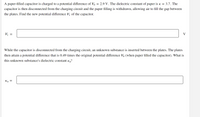Question

Transcribed Image Text:A paper-filled capacitor is charged to a potential difference of Vo
2.9 V. The dielectric constant of paper is K =
3.7. The
capacitor is then disconnected from the charging circuit and the paper filling is withdrawn, allowing air to fill the gap between
the plates. Find the new potential difference V of the capacitor.
V1 =
V
While the capacitor is disconnected from the charging circuit, an unknown substance is inserted between the plates. The plates
then attain a potential difference that is 0.49 times the original potential difference Vo (when paper filled the capacitor). What is
this unknown substance's dielectric constant K,?
Ku =
Expert Solution
This question has been solved!
Explore an expertly crafted, step-by-step solution for a thorough understanding of key concepts.
This is a popular solution
Trending nowThis is a popular solution!
Step by stepSolved in 3 steps with 3 images

Knowledge Booster
Similar questions
- A potential difference exists between the inner and outer surfaces of the membrane of a cell. The inner surface is negative relative to the outer surface. If 1.15 x 10-20 J of work is required to eject a positive sodium ion (Na*) from the interior of the cell, what is the magnitude of the potential difference between the inner and outer surfaces of the cell? magnitude of the potential difference: Enter numeric valuearrow_forwardFour uncharged capacitors with equal capacitances are combined in series. The combination is connected to a 7.65 V battery, which charges the capacitors. The charging process involves 0.000193 C of charge moving through the battery. Find the capacitance C of each capacitor. C = Farrow_forwardAn air-filled parallel-plate has capacitance Co. When it is connected to a battery with EMF Vo, it has charge Qo and stored energy Ub- The gap is then filled with a slab of material that has dielectric constant K. Which of the following physical quantities do increase by factor of k when the dielectric material is inserted between the plates? Vo Vo The potential difference, charge, and potential energy stored in the capacitor. The charge, capacitance, and potential energy stored in the capacitor. O The potential difference and potential energy stored in the capacitor. O The potential difference across the parallel-plate capacitor and the charge.arrow_forward
- Problem 6: Suppose you have a 9.00 V battery, a 3.8 μF capacitor, and a 7.85 μF capacitor. Part (a) Find the total charge stored in the system if the capacitors are connected to the battery in series in C. Part (b) Find the energy stored in the system if the capacitors are connected to the battery in series in J. Part (c) Find the charge if the capacitors are connected to the battery in parallel in C. Part (d) Find the energy stored if the capacitors are connected to the battery in parallel in J.arrow_forwardA parallel-plate capacitor is made of two square plates 40 cm on a side and 1 mm apart. The capacitor is connected to a 40-V battery. What is the energy stored in the capacitor? μJ. With the battery still connected, the plates are pulled apart to a separation of 2 mm. What is the energy stored in the capacitor now? μJ. This time, starting from situation in (a), with the batteries disconnected (but capacitors still charged), the plates are pulled apart to a separation of 2 mm. What is the energy stored in the capacitor now? μJ.arrow_forwardIn the figure the battery has a potential difference of V = 10.0 V and the five capacitors each have a capacitance of 9.00 uF. What is the charge on (a) capacitor 1 and (b) capacitor 2? FF (a) Number i (b) Number i Units Unitsarrow_forward
- The capacitance of a parallel-plate capacitor can be increased by: O increasing the charge O decreasing the charge O increasing the plate separation O decreasing the plate separation O decreasing the plate areaarrow_forwardA 10.0-µF capacitor is charged so that the potential difference between its plates is 10. V. A 5.0-µF capacitor is similarly charged so that the potential difference between its plates is 5.0 V. The two charged capacitors are then connected to each other in parallel with positive plate connected to positive plate and negative plate connected to negative plate. What is the final potential difference across the plates of the capacitors when they are connected in parallel? O 8.3 V O 6.7 V O 10 V O 7.5 V O 5.0Varrow_forwardA capacitor of unknown capacitance is connected across a battery of V volts. The charge stored in it is 300 µC. When potential across the capacitor is reduced by 100 V, the charge stored in it becomes 100 V. Calculate the potential V and the unknown capacitance. What will be the charge stored in the capacitor if the voltage applied had increased by 100 V?arrow_forward
- Four uncharged capacitors with equal capacitances are combined in parallel. The combination is connected to a 7.23 V battery, which charges the capacitors. The charging process involves 0.000475 C of charge moving through the battery. Find the capacitance C of each capacitor.arrow_forwardConsider the setup of two capacitors and a DC power supply is shown in the figure. The potential difference is (6.4x10^1) volts, and the capacitors have capacitances C₁ = (3.700x10^0) µF and C₂ = (4.800x10^0) µF. What is the charge on the capacitor plate labelled A in the figure (connected to the anode of the voltage supply). Give your answer in unit of coulombs (C) using scientific notation. + AV C₁ C₂ I A Barrow_forwardA capacitor C1=3μFC1=3μF is connected across a 20V battery. The battery is removed and the capacitor is reconnected to another capacitor C2=8μFC2=8μF. What are the final charges and potential differences for the capacitors?arrow_forward
arrow_back_ios
SEE MORE QUESTIONS
arrow_forward_ios